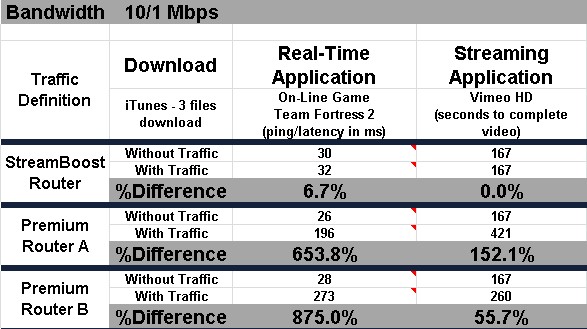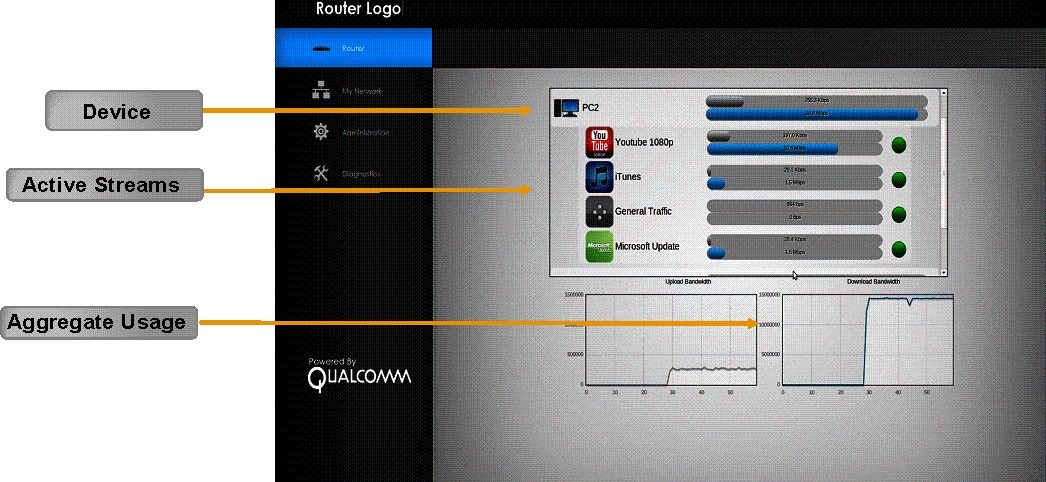Routers with Qualcomm Atheros’ VIVE draft 802.11ac technology inside are starting to hit the market. One of VIVE’s claims to fame is its StreamBoost feature that is based on technology acquired with Qualcomm’s purchase of Bigfoot Networks.
We asked Qualcomm Atheros to explain why StreamBoost is different from other automatic QoS schemes. This is what they came up with.

The basic idea of StreamBoost
In today’s homes, network demands are dramatically increasing with the growing number of applications being delivered through the Internet. A quick survey of the leading routers on the market will show that most claim to have quality of service (QoS) capabilities that ensure performance for key applications like video streaming or online gaming.
Clearly there is a demand for improved home router performance. But standard QoS doesn’t fully address the requirements in homes with ever-increasing demands on the network. What’s needed is a new technology that dynamically adjusts to provide the best possible user experience for every application on the home network.
Consider a typical scenario that highlights the current home network dilemma: three users on a home network that has 10 Mbps Internet service. (Note the average US home service in 2013 is 7.4 Mbps, reference: Akamai State of the Internet, Q4 2012):
- TV viewing a streaming movie
- PC playing an online game
- Tablet downloading movies
Assume the home has a router using QoS features typically available today. The likely outcome will be that the download is slowed somewhat, the TV’s video is either stalling or has shifted to a lower resolution, while the online game is experiencing significant lag. And despite manufacturers’ claims, these experience issues persist in today’s homes.
Before diving into the different QoS schemes, it is important to understand that Internet applications are not all the same. An online game consumes little bandwidth, but requires real-time performance (like VoIP). Any data buffering causes increased latency. Video streaming requires varying amounts of bandwidth based on resolution, well-paced data for decoding consistency and often employs highly aggressive forward buffering techniques to increase the likelihood of smooth video delivery. And finally, download applications (e.g. media downloads or Torrents) are bulk data transfers that aggressively consume bandwidth. Though important, they are not time-critical.
In simple terms, there are three network traffic methods: fair sharing, priority QoS and traffic shaping. Today’s routers generally employ the first two techniques, but these are not enough to address the increasingly busy and contentious home network.
The basic method for arbitrating home network traffic is “fair sharing,” where the router allocates bandwidth on an equal basis, independent of what the application actually needs. Thus, streaming and download applications will equally divide 10 Mbps of available bandwidth, resulting in 5 Mbps for each. Since 1080p HD video generally requires 6 Mbps or more to operate properly, high resolution video will have trouble either playing continuously or be knocked down in resolution, depending on the type of media service. An online game will be stuck behind both these high bandwidth apps and the user will notice significant latency, rendering the game unplayable.
Most performance claims are backed by priority QoS techniques where specific applications are prioritized at the expense of other traffic on the network. Priority QoS can show improved performance for a single media application as the lower priority application is suppressed to allow for more bandwidth for the prioritized application. This scheme breaks down, however, as more media applications are introduced and then have to share fairly at the single priority level. And finally, priority QoS breaks down in the online game case, as it and media streaming require different treatment and do not do well when running simultaneously.
Traffic Shaping
Traffic shaping techniques account for each individual application and dynamically shape the network for “best fit” performance as they become active, for both up and downlink directions. Traffic shaping starts with knowing the total bandwidth available and has the ability to detect applications as they start. It is aware of the connected devices and knows the network policies required for each application in terms of both bandwidth allocation and buffering.
Going back to the initial user scenario, the resulting user experience with proper traffic shaping is flawless video performance by offering the video stream exactly the bandwidth that it requires. Low gaming lag is produced by also enabling lower buffering. And finally, the data download application is alloted only the remaining bandwidth.
The ideal solution offers traffic shaping through the following differentiating technologies:
- Statistical Application Detection – Each application is comprised of data streams that have specific attributes. Statistical application detection has the ability to analyze multiple attributes of the stream itself, build a statistical model based on the analysis and make a comparison to a table of known applications. This method is quick, computationally lightweight and highly reliable for detailed application detection.
- Device Detection – Devices are detected through a similar attribute analysis, and the device information is an important factor in determining the appropriate policy. As an example, higher resolution video affects viewing quality more significantly on a large-screen TV as opposed to a smartphone. Traffic shaping rules take into account that if a TV is displaying video, the policies can allocate more bandwidth.
- Traffic Shaping Policies – A policy engine includes the following inputs: total available bandwidth at the wide area network (WAN) interface, active detected applications and associated device types. Traffic shaping is generally most critical at the WAN interface as it is the most constrained interface in the home network. LAN and Wi-Fi connections offer much greater throughput than the typical bandwidth offered by most service providers – 10-20 Mbps at the WAN versus 300-1000+ Mbps over Wi-Fi/LAN.
The policy engine would apply its traffic shaping rules so that each individual application is allocated in the network seeking a “best fit” schema to fit the available WAN bandwidth in both up and down directions. Streaming applications have different requirements for resolution versus bandwidth, but also can differ whether the applications are offered in fixed versus adaptive resolution.
In both fixed and adaptive media offerings, an optimal resolution should be set in the policy table for the best performance. But in an adaptive resolution case, the policy engine should have the ability to shape this media type to a lesser, but good experience resolution (e.g. 1080p to 720p). This will enable more users with effective experiences on the network.
Real-time applications are always classified to operate with minimal buffering, so online games operate without lag and VoIP audio is crystal clear. Bulk data applications are not set to arbitrary limits, but rather allowed to operate within available best-efforts bandwidth ensuring consistent data flow that does not interfere with protected-class applications.
StreamBoost
StreamBoost is Qualcomm’s answer to the QoS challenges described above. In addition to the above capabilities, StreamBoost includes a cloud service that updates the router on a regular basis so that more applications and devices can be identified to ensure optimal performance. This allows StreamBoost to grow and adapt to the dynamic nature of the internet.
The net performance result with StreamBoost is that it is now possible to have a happy digital household with unprecedented numbers of simultaneous users. The table below shows actual results for the StreamBoost router in the same three-user scenario as compared with two leading premium routers on the market today.

StreamBoost Test summary and comparison
Test Details
Each test router is connected to a dedicated residential cable modem line that provides 10 Mbps down / 1 Mbps up bandwidth. Three notebook computers are connected via Ethernet to the router under test.
Notebook 1 runs the game TF2, notebook 2 runs an iTunes download and notebook 3 plays a Vimeo streaming video, Vimeo
In the table above, "without traffic" means that the application’s performance is being measured without any other application active. "With traffic" means that the performances are being measured while all three applications are simultaneously active. The applications are started within 1-2 seconds of each other.
Game latency can be highly variable, so several readings are taken during the test and an average calculated. Vimeo play time is measured with a stopwatch. The iTunes download is not measured; it runs to simulate an overloaded network.
A StreamBoost router also includes a web-based (HTML5) interface that helps the user understand how StreamBoost is working. Shown below is an expanded view into the router displaying the interaction of a device, its active applications and how it relates to the total bandwidth usage.

Since StreamBoost routers perform right out of the box with little to no user configuration, this interface will be used mostly for information purposes.
Pete Tao is a Staff Product Manager, Qualcomm Atheros.
